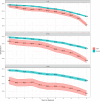Sociodemographic traits as early indicators of AD, FTD, and VaD up to 10 years before diagnosis
- PMID: 40990183
- PMCID: PMC12457979
- DOI: 10.1002/alz.70616
Sociodemographic traits as early indicators of AD, FTD, and VaD up to 10 years before diagnosis
Abstract
Introduction: We aimed to investigate early differences in sociodemographic factors before the onset of Alzheimer's disease (AD), frontotemporal dementia (FTD), vascular dementia (VaD), and mixed dementia (AD + VaD).
Methods: Lifetime sociodemographic factors were collected from Statistics Finland for 1238 AD, 274 FTD, 343 VaD, and 402 AD + VaD patients with a diagnosis and visit at Kuopio and Oulu University Hospitals between January 2010 and December 2021. Comparisons were performed between dementia groups and matched controls.
Results: All patient groups showed decreased employment status compared to controls already 10 years prior to diagnosis. In particular, individuals with early-onset FTD (EOFTD; 66.9% vs. 77.6%, p < 0.01) and early-onset VaD (EOVaD; 49.0% vs. 76.5%, p < 0.001) had significantly lower employment rates than controls. Similarly, 10 years prior to diagnosis the proportion of married individuals was lower in the VaD (60.1% vs. 65.2%, p < 0.05) and EOVaD (50.0% vs. 61.6%, p < 0.05) groups versus controls, while single status was more common in early-onset AD (EOAD; 23.2% vs. 17.0%, p < 0.01) versus controls. Patients with VaD and AD + VaD had lower levels of education than controls: basic education only in 51.9% of VaD (vs. 45.0%, p < 0.05) and 65.7% of AD + VaD (vs. 60.2%, p < 0.05).
Discussion: Our findings may aid in the early recognition or potential risk factor evaluation for different types of dementia. Screening cognitive symptoms in individuals with unexplained long-term unemployment may help detect prodromal dementia.
Highlights: Employment rates were already reduced 10 years before the diagnosis of Alzheimer's disease, frontotemporal dementia, and vascular dementia. The association between education level and dementia risk appears to be subtype specific. Lower employment may serve as an early "social marker" of subtle cognitive decline. Social markers could help inform models predicting progression to cognitive impairment.
Keywords: alzheimer's disease; education; frontotemporal dementia; marital status; sociodemographics; vascular dementia.
© 2025 The Author(s). Alzheimer's & Dementia published by Wiley Periodicals LLC on behalf of Alzheimer's Association.
Conflict of interest statement
The funders of the study had no role in study design, data collection, data analysis, data interpretation, or writing of the report. E. Solje has served on the advisory board of Novartis, Eisai, Lilly, and Roche; served as a consultant for Novo Nordisk, BioArctic, Eisai, Lilly, and Roche; received honoraria for lectures from Lundbeck, BioArctic, Lilly, and Roche; received support for attending a conference from Lilly; and received payment for expert testimony from BioArctic. J. Krüger has served on the advisory board of Novartis, Eisai, Lilly, Nutricia, and Roche; received honoraria from lectures from BioArctic and Lilly; and received support for congress participation from Merck and Lilly. S. Heikkinen has received lecture fees from Finnish Brain Association and Nordic Infucare. A. Kivisild has received travel support for congress participation from Merck and Infucare. Other authors report no conflicts of interests. Any author disclosures are available in the supporting information. This study is part of DEGE‐RWD project, funded by Roche Oy. Other funding: A.H. (Sigrid Jusélius Foundation), S.H. (Finnish Brain Foundation, The Finnish Parkinson Foundation), K.K. (Finnish Brain Foundation, Uulo Arhio Foundation, The Finnish Medical Foundation, The Finnish Cultural Foundation), A.K. (The State Research Funding, Finnish Brain Foundation), J.K. (Wihuri Foundation, The State Research Funding), E.S. (Wihuri Foundation, Sigrid Jusélius Foundation, The State Research Funding), H.S. (Finnish Brain Foundation).
Figures


References
MeSH terms
LinkOut - more resources
Full Text Sources
Medical

